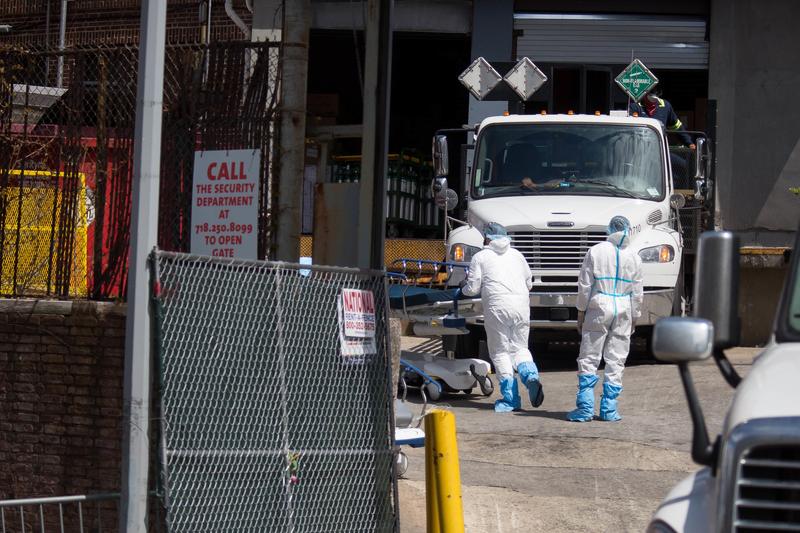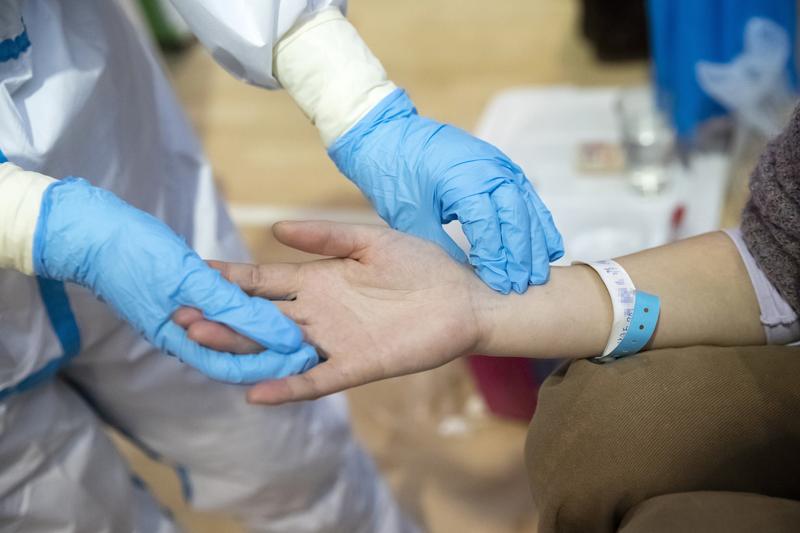 A medical worker wears protective equipment before entering the isolation ward at Wuhan No.1 Hospital in Wuhan, central China's Hubei province, Feb 22, 2020. (PHOTO / XINHUA)
A medical worker wears protective equipment before entering the isolation ward at Wuhan No.1 Hospital in Wuhan, central China's Hubei province, Feb 22, 2020. (PHOTO / XINHUA)
BEIJING — While governments worldwide are still racing against the clock to contain the novel coronavirus disease (COVID-19) within their own countries, US President Donald Trump took comfort in his accusations over death toll numbers in different countries.
The US president said in a contentious White House press briefing on Saturday: "Does anybody really believe these figures?" and insinuated that China had underreported the fatalities it suffered from the coronavirus outbreak, citing China's death per 100,000 people at 0.33.
Though China's population is more than four times that of the United States, the number of COVID-19 deaths in China was less than 10 percent of the US
China has reported 4,642 coronavirus deaths as of April 24, compared with 49,954 deaths in the United States, according to data from the World Health Organization (WHO) and Johns Hopkins University.
 Healthcare workers push hospital beds after bringing deceased patients to a temporary morgue outside Brooklyn Hospital Center during the coronavirus pandemic in the Brooklyn borough of New York, the United States, April 14, 2020. (PHOTO / XINHUA)
Healthcare workers push hospital beds after bringing deceased patients to a temporary morgue outside Brooklyn Hospital Center during the coronavirus pandemic in the Brooklyn borough of New York, the United States, April 14, 2020. (PHOTO / XINHUA)
ALSO READ: Fewer virus deaths easy to explain
Various death rates
What does the death rate mean? Why does it vary in different countries?
According to the mortality analyses by Johns Hopkins University, the deaths per 100,000 people in the United States was 15.27 on April 24, compared with a mere 0.33 in China.
Fluid due to the increase of mortalities, the death per 100,000 people measures the outbreak's severity facing the entire population of a country.
If two countries have the same death toll, the death per 100,000 people for the country with a larger population will be lower. That is one of the reasons why China's death rate per 100,000 people is a mere 0.33 -- the country has a population of 1.4 billion.
China first bore the brunt of the outbreak, and further analysis in breakdown shows the mortality rate per 100,000 people varies in its different regions, too.
Take the hardest-hit city, Wuhan, for example. After the coronavirus was first detected in the city, capital of Hubei province, in late December 2019, local hospitals were once overwhelmed by large numbers of infected patients in the early stages of the outbreak, a predicament that was repeated in many Western countries.
With a population of more than 11 million, Wuhan saw the coronavirus death per 100,000 people at around 35.17 as of April 23, while that for Hubei province, with a population of over 59 million, stood at around 7.6, compared with 0.33 nationwide, as calculated using data from China's National Health Commission (NHC).
 Aerial photo taken on Jan. 26, 2020 shows the Yellow Crane Pavilion and the Yangtze River Bridge during a lockdown to contain the epidemic in Wuhan, central China's Hubei province. (PHOTO / XIHHUA)
Aerial photo taken on Jan. 26, 2020 shows the Yellow Crane Pavilion and the Yangtze River Bridge during a lockdown to contain the epidemic in Wuhan, central China's Hubei province. (PHOTO / XIHHUA)
Thanks to the resolute measures including a strict 76-day lockdown of Wuhan, the coronavirus outbreak in China was largely contained in Hubei. The province took up 97.4 percent of deaths and 82.3 percent of confirmed cases in the Chinese mainland.
Another indicator, the case-fatality ratio or the deaths-to-infections ratio, which calculates the rate by dividing total deaths by the number of confirmed cases, is also widely used to reflect both the severity of the outbreak and the effectiveness in the treatment of patients.
Belgium, France, UK, Italy, the Netherlands, Spain, Iran, the United States, China and Germany were ranked by Johns Hopkins University as the top 10 countries that have the most deaths proportionally to their COVID-19 cases. The proportion in the United States was 5.7 percent and that in China stood at 5.5 percent on April 24.
 The empty Grand Place is seen in Brussels, Belgium, April 13, 2020. (PHOTO / XINHUA)
The empty Grand Place is seen in Brussels, Belgium, April 13, 2020. (PHOTO / XINHUA)
Globally, the deaths-to-infections ratio stood at about 6.9 percent by April 22, with 175,694 deaths and over 2.54 million confirmed cases worldwide, according to WHO data.
That means about 6.9 percent of people known to be infected with the coronavirus have died worldwide, underscoring how deadly the virus could be.
NHC official Jiao Yahui said a series of decisive measures taken by the Chinese government since late January are the variants that matter
ALSO READ: Keeping the virus at bay on the world stage
Lessons beyond math
Of those different death rates, what makes the difference? What things has China done right to bring COVID-19 under control?
NHC official Jiao Yahui said a series of decisive measures taken by the Chinese government since late January are the variants that matter.
Such measures, including strict quarantine policy, dispatching medical professionals nationwide to Hubei, building makeshift hospitals, treating patients in severe conditions with the country's best resources and making full use of traditional Chinese medicine (TCM), have helped China flatten the infection curve and largely contain the contagions within Hubei province, Jiao said.
 A medical worker examines a patient with traditional Chinese medicine therapies at a temporary hospital in Jiangxia District in Wuhan, central China's Hubei province, Feb 25, 2020. (PHOTO / XINHUA)
A medical worker examines a patient with traditional Chinese medicine therapies at a temporary hospital in Jiangxia District in Wuhan, central China's Hubei province, Feb 25, 2020. (PHOTO / XINHUA)
Total lockdown of Wuhan & nationwide response
China began the 76-day lockdown of outbound channels in Wuhan on Jan. 23 as part of its nationwide emergency response efforts, and the situation started to improve subsequently.
The central government allocated and transferred funds to Hubei and pooled resources from other parts of the country to guarantee the normal lives of local residents in Wuhan and Hubei.
Wearing face masks or not made a big difference in preventing healthy people, particularly medics, from contracting COVID-19, said Wang Xinghuan, president of the Zhongnan Hospital of Wuhan University.
None of those medics who wore masks while contacting the patients in the hospital were infected, but some medics from non-COVID-19-treating departments who had not worn masks contracted the coronavirus at the early stage of the outbreak, Wang said.
Placing patients with mild symptoms under home isolation could transmit the virus to more family members, Wang said, citing lessons Wuhan has learned by reporting many cases in which one patient infected three, five or six family members in the early days of the outbreak.
To solve this problem, Wuhan later converted public facilities, including gyms and exhibition centers, into 16 temporary hospitals that helped quarantine patients with mild symptoms, while inaugurating two hospitals from scratch -- Huoshenshan and Leishenshan -- within two weeks between late January and early February to treat COVID-19 patients after local hospitals were overwhelmed.
Tackling the huge challenge of the strained medical resources, more than 42,000 medics from across the country were assembled and dispatched to Hubei to help treat coronavirus patients.
During the peak period of the epidemic, Wuhan has a total of 60,000 hospital beds to meet the surging demand for medical resources.
"This is one of the reasons that we have a rather high patient cure rate and a low mortality rate," Jiao said, adding the prompt intervention of the TCM in the whole process of treatment has been proved especially effective in alleviating early symptoms and shortening the time that patients needed to test negative.
 Aerial photo taken on Feb. 2, 2020 shows the Huoshenshan Hospital in Wuhan, central China's Hubei province. (PHOTO / XINHUA)
Aerial photo taken on Feb. 2, 2020 shows the Huoshenshan Hospital in Wuhan, central China's Hubei province. (PHOTO / XINHUA)
Different regions, different measures
The total lockdown of Wuhan and the national emergency response measures have helped reduce the confirmed cases in other Chinese cities by 96 percent than expected, said Zhang Wenhong, head of the Center for Infectious Disease with Shanghai-based Huashan Hospital of Fudan University, during a webinar on Wednesday between Chinese and US medical professionals.
Many provinces, municipalities and autonomous regions swiftly initiated the top level of the public health alert system that involves the government, medical facilities and the community when the lockdown of Wuhan began.
In other parts of China where the epidemic was at different stages, slow-down, shut-down or lockdown strategies were adopted for those at the early stage, progressive stage and outbreak stage, respectively, Zhang said.
China's tough measures to stop the spread of the coronavirus in the first 50 days of the epidemic in Wuhan have bought other cities across the country valuable time to prepare and install their own restrictions
Slow-down measures, including testing, tracing, social distancing and patient hospitalization, were adopted in regions like Shanghai; shut-down measures, including testing, tracing, stay-at-home order for healthy people and closing recreational sites, were adopted in regions at the progressive stage; and lockdown measures were adopted in Wuhan and other cities in Hubei to break the transmission chain.
At the Sino-US joint webinar, Zhang shared China's five-point experience in medical and health control of the epidemic: All suspected cases were tested twice by CDC; all diagnosed patients were admitted to designated hospitals; all nucleic acid tests and treatments were free; all patients were traced and quarantined; and in epidemic outbreak regions, the transmission chain was broken and temporary shelter models set up.
READ MORE: China refutes US accusation over transparency in handling virus
China's tough measures to stop the spread of the coronavirus in the first 50 days of the epidemic in Wuhan have bought other cities across the country valuable time to prepare and install their own restrictions, according to a paper published in late March in the journal Science by researchers from China, the United States and Britain.
By Feb 19 there were 30,000 confirmed cases in China, said Oxford fellow Christopher Dye, co-author of the paper. "Our analysis suggests that without the Wuhan travel ban and the national emergency response there would have been more than 700,000 confirmed COVID-19 cases outside of Wuhan by that date," he said. "China's control measures appear to have worked by successfully breaking the chain of transmission -- preventing contact between infectious and susceptible people."


